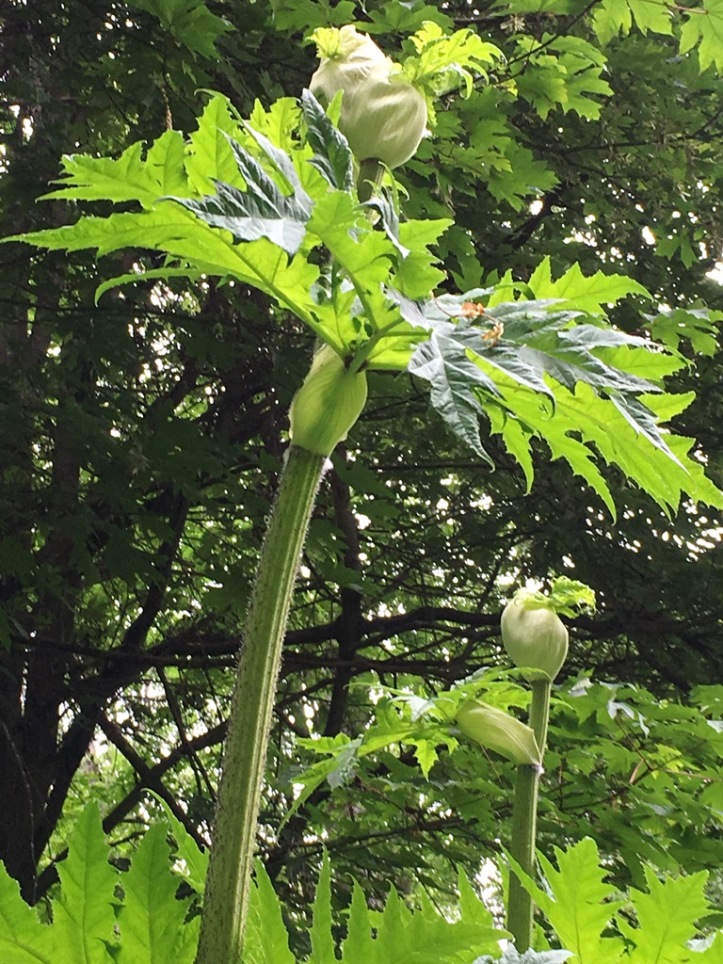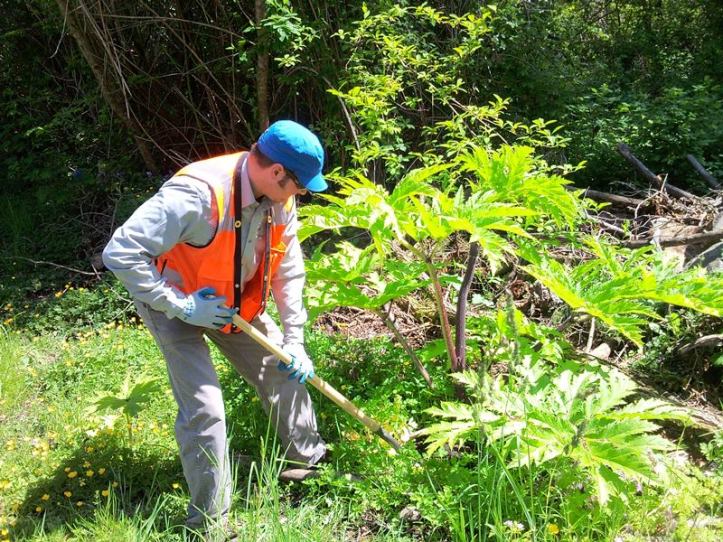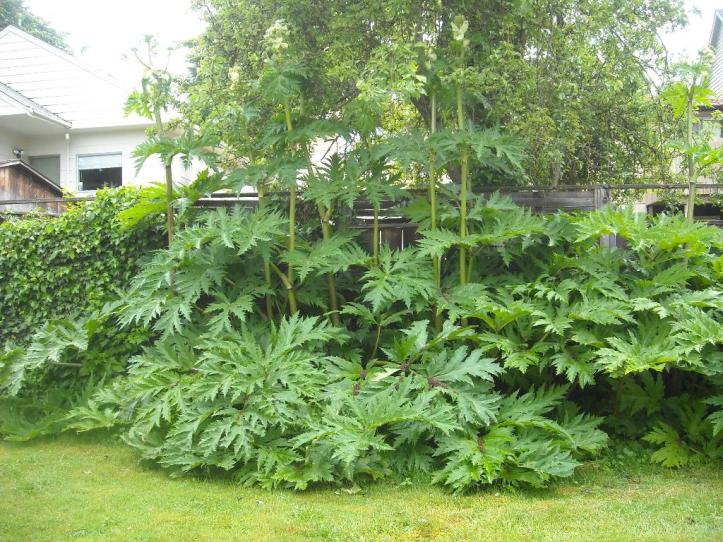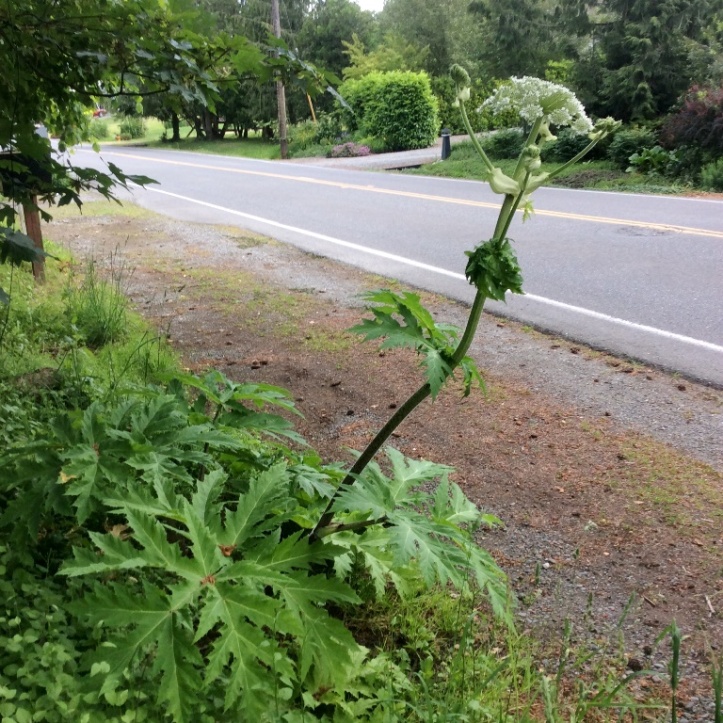Giant hogweed has earned a fearsome reputation due to its massive, striking appearance and its ability to cause horrible blisters if you get the juice on your skin. June is the month hogweed plants typically reach their full size of 10 to 15 feet tall. Mature plants form large bulb-like structures on the tops of their massive stems that then open up into giant umbrella-style flower clusters.


It is often in June that our office gets calls from worried homeowners wondering about the crazy monster plants that showed up in their backyards or ravines. See our giant hogweed page for photos and identification information. For an entertaining musical interpretation of hogweed’s history in England, check out the Genesis song The Return of the Giant Hogweed.
Giant hogweed has an interesting life cycle that sometimes helps it avoid detection in spite of its massive size. The plant takes several years to build up root energy before it produces its impressive flowering stem. In those years, people might not notice the plants growing among the blackberries or hidden in the bushes on a hillside.
When it has stored up enough energy, hogweed uses its massive root reserves to form a single giant flowering stalk with zillions of densely packed, small white flowers.

When the seeds mature, the giant stem topples over, allowing the seeds to fall away from the parent plant and wash downhill or be carried by animals or water into new areas.
Hogweed is very successful at spreading by seed. I once saw an entire yard filled with tiny hogweed seedlings. The next door neighbor had allowed a hogweed seed head to fall over his fence into the yard. Our program was called when children got blisters from running barefoot through the yard, and their mother realized it had something to do with the little plants growing all over her lawn.

Another time, we found a huge patch of giant hogweed along the side of Stevens Pass Highway. It seems likely that someone dumped their yard waste there including a giant hogweed seed head. Hogweed seeds have a very high rate of germination, so it just takes one giant seed head to populate a whole new area.
Giant hogweed is a Class A noxious weed in Washington due to its relatively limited distribution in the state and its serious impacts. Our program has significantly reduced the number of infestations in King County since we began in the late 1990’s. However, the plant is so invasive and persistent that it is still not uncommon for us to find new patches of hogweed in the county. It is important to get in touch with our staff if you see hogweed, because of the high risk of getting burned from its sap. We want to make sure there aren’t more plants in the area and that everyone safely removes it to keep it from spreading further.
Because hogweed roots are so massive, cutting the plants down doesn’t kill them. In fact, cutting will often prolong the plant’s life since hogweed will continue to grow until it forms seeds. Either the roots have to be dug up or the plants have to be sprayed with an herbicide. Flower heads have to be carefully cut, bagged and discarded in the trash. Make sure to wear gloves, long sleeves, pants, shoes and eye protection when controlling hogweed. If you get hogweed juice on your skin, wash immediately and try to keep the exposed area out of the sun for a couple of days.

Although giant hogweed is distinctive, it can easily be confused with a very similar native plant called cow parsnip. Cow parsnip usually starts flowering earlier than hogweed, usually early June, compared with late June to July for hogweed. Cow parsnip is also generally smaller, typically reaching only 4 to 6 feet tall, or sometimes up to 8 feet, with a smaller flower head with fewer flower clusters.
Cow parsnip is a common plant along trails in the mountains and along the coast, and can sometimes even show up in city parks. It also has toxic sap than can cause burns, but less so than hogweed, and it generally isn’t nearly as invasive and overwhelming as giant hogweed can be. Cow parsnip is also native to North America, unlike giant hogweed, which originated in Russia. If you are uncertain about identification, take photos and email them to us or call our program at 206-477-9333 and we can walk through how to distinguish the plants.
Another plant often confused with giant hogweed is poison-hemlock. Both plants start as clumps of large leaves and then form a tall, central, purple-blotched stem. However, poison-hemlock leaves are finely-divided like parsley and the flowers are in loosely arranged small clusters all over the upper stems, not in one densely-packed, central structure like hogweed. Also, poison-hemlock is very common in King County, unlike giant hogweed, and its control is not required (but definitely recommended).
One website I found useful for distinguishing giant hogweed from its look-alikes is from New York State’s Department of Environmental Conservation.
In order to make sure giant hogweed doesn’t spread, we need everyone’s help in watching for this plant. If you see any giant hogweed in King County, we urge you to report it to us right away. The last few infestations of a noxious weed are the hardest to find, so we need all the help we can get. Please visit our web page on giant hogweed for more information, check our online map to see where we have found giant hogweed, and report giant hogweed locations online.












